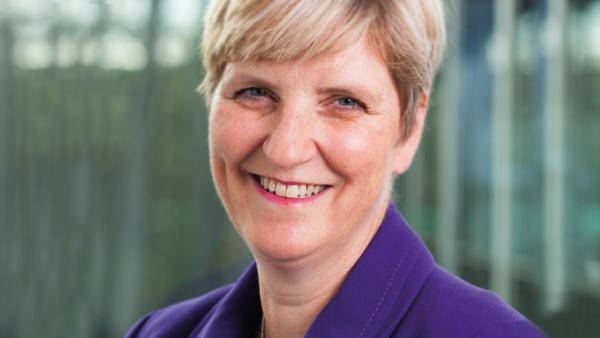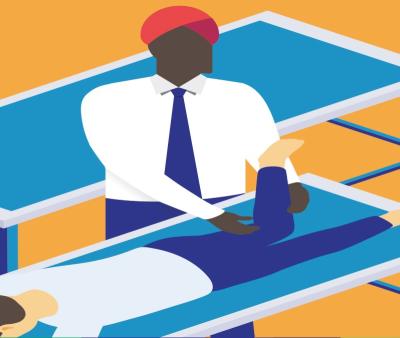Get inspiration and advice to help you get ready to put the updated HCPC standards of proficiency into practice

Get ready for changes to the HCPC standards of proficiency
By 1 September all HCPC registrants must be ready to integrate the updated HCPC standards of proficiency in their practice. The standards form the baseline against which a registrant will be judged should a fitness to practise complaint be made against them. Failure to meet the standards could therefore result in sanctions from the HCPC – including being removed from the register.
So how should physiotherapists prepare? In this article we offer expert advice, guidance and signpost to ideas and resources to help you take action so you can get ready to embed the updated standards into your practice.
Leadership
Team or individual activities
Look for/discuss in your supervision opportunities across your team/pathway or wider service such as shadowing, acting up, chairing meetings, organising team training opportunities, offering to support a student placement or be involved with a practice improvement project or audit.
SWOT analysis – reflect on your role and what opportunities you have to show leadership – what kind of leader are you?
Join the CSP mentoring scheme.
Join your CSP regional network committee
Become a CSP workplace steward or rep.
Resources
Kings Fund courses – An introduction to leading with kindness and compassion in health and social care.
Leading well for staff health and wellbeing in the NHS
Leadership for personalised care
CSP leadership resources
HCPC guidance on how to prepare
We put key questions about the changes to Kim Tolley, interim head of professionalism and upstream regulation at the HCPC.

What do physiotherapists need to know about the changes?
The updated standards come into effect on 1 September. By then, all HCPC-registered physiotherapists will need to understand how the changes affect them and be ready to integrate them into their practice.
The changes fall into the following key themes, which you can learn more about on our website:
- equality, diversity, and inclusion
- centralising the role of the service-user
- promoting public health and preventing ill-health
- registrant’s mental health
- digital skills and new technologies
- leadership at all levels of practice
The standards were revised following extensive consultation with a range of stakeholders, including registrants. As a result, the key themes should resonate with changes that you have seen in your own physiotherapy practice.
The updates are more than just words: they are aspects of care that, we know, physiotherapists grapple with on a daily basis.
What should our members do to get ready?
The first step we recommend is to inventory your own practice, with regards to the updated standards. Ask yourself what aspects you are proud of, what aspects you don’t know enough about and what aspects could be embedded more in your day-to-day work.
The second step is to collect support materials about the changes. What has been written and where? The CSP has clear material available to members about this can be found here and here titled HCPC standards for physiotherapists and Health and Care Professions Council raising the standards.
The HCPC also has webpages that go through the changes that have been made and the reasons why these changes have been written titled 'Revisions to the standards of proficiency'. We also have a blog for easy reading, which provides background to the updates and what they are doing to help registrants. There is also a series of webinars specifically designed to help embed these updates and to support HCPC registrants in meeting the standards.
The third step is to talk to your colleagues about the changes. Are you all feeling the same way? What can you learn from each other about your reflections? Where can you discuss this – perhaps at a team or ward meeting, during supervision or with your employer?
The fourth step is to formalise this whole process by using a gap analysis tool. Our gap analysis tool (find attached below) has already helped physiotherapists to reflect on these areas and identify what they may need to focus on during continuing their professional development (CPD) – this can feed into your annual appraisals or supervision.
The gap analysis tool can also be used to drive changes in your practice or service and to lobby managers to support you in integrating the changes into your practice.
Do you have any advice for physios to consider when they are working under pressure to be able to meet the changes?
You don’t need to do the steps above all at once, take them gradually over the next few months.
A key part of this can be sharing your progress with the teams you work with, which will mean you can embed the changes together and reduce the individual burden. Even sole practitioners can seek supervision and/or support to achieve the same result.
We also recommend that you disseminate your reflections and improvements on the CSP website, and use others’ thoughts as a resource.
Jamie the university lecturer
Jamie is a physiotherapy lecturer who is aware that it’s their responsibility as a registrant to be practicing in line with the standards changes by 1 September. Jamie considers how to prepare as an individual and also how to prepare their students.
Jamie looks on the CSP professional guidance webpages which links them to pertinent HCPC resources. They complete the HCPC gap analysis tool highlighting priority areas of development.
As Jamie’s not working clinically, they can’t demonstrate that they are meeting all of the standards. The CSP and HCPC advises that as long as they are practising safely and effectively, within their given scope of practice, and do not practise in the areas where they are not proficient to do so, this will not be a problem. Jamie is reassured by this.
Jamie identifies a number of priority areas of development – with their highest being an understanding of their own mental health and wellbeing in maintaining fitness to practise.
Jamie signs up for the HCPC webinars on the standards change, including one on mental health. They discuss their gap analysis in supervision. Jamie is directed to work-based resources and policies which are pertinent. As a result of this Jamie proposes a change to their supervision template to include an opportunity to touch base about the supervisee’s wellbeing during each session – this change is rolled out across the team. Jamie also runs tutorial for their students on safeguarding your mental health when working in healthcare and develops a peer support network for students who are on placements with a focus on mental health and wellbeing.
Wellbeing
Team or individual activities
Listen to the HCPC webinar recording on registrants’ mental health. Speak to your workplace CSP safety rep, or consider becoming a safety rep: bit.ly/3TYbAMB
Request support to debrief after being involved in challenging situations. Investigate if your organisation has a specialist team to support with this. Request that wellbeing check points form part of your routine such as during supervision or peer support sessions. Look into your employer’s support networks for example wellbeing champions, counselling, free activities for staff. Look into psychological safety – consider the NICE guidelines on Mental Wellbeing at Work.
Resources
The Academy of Fabulous Stuff – a social movement for sharing health and social care ideas, services and solutions that work:
CSP health and safety resources with a focus on managing your mental health in the workplace - Mental health resources and helplines and Occupational stress.
NHS Kindness and Positivity Network.
5 steps to mental wellbeing.
Top tips to improve your mental wellbeing
NHS Employers – Evidence based approaches to workforce wellbeing.
NHS Scotland – Thrive – Mental Wellbeing
Promoting public health and preventing ill-health
Team or individual activities
Discuss as a team if the data your service collects helps you understand if your service is welcoming and accessible to all groups from your population. Find out about your local healthcare organisations’ strategy regarding public health. Are there public health teams you could link with to help your understanding? Review government guidance and reflect if you can make small changes to your practice to promote public health and prevent ill-health. Scotland, England, Northern Ireland, Wales.
Resources
Future Learn Courses
Do you know your population?
King’s Fund resources: health inequalities framework
CSP webinar – Empowering your population in primary care
Centralising role of service user
Team or individual activities
Reviewing service user feedback options within a team – how do you get service user feedback, act on this and communicate any changes? Is this process equitable and are there barriers for some service users? (consider the CSP advice on using data meaningfully). Reflect on the personalised care knowledge that you have – is this knowledge being effectively translated into your practice? Consider and share with your team/leads ideas that you have which could improve this and look for support to action your suggestions.
Resources
Personalised Care Institute: Your learning options plus their endorsed e-learning.
Using technology to optimise personalised care – reflect on the CSP remote consultation guidance which champions a hybrid, equitable personalised model of consultations.
Developing collaborative services – look for opportunities to include service users in your evaluation and development plans.
Bharat the ACP

Bharat is an advanced clinical practitioner (ACP) in primary care. His ACP role title no longer includes physiotherapist. However, he’s still required to maintain his primary registration as a physiotherapist with the HCPC and therefore prepare for the standard of proficiency (SOP) changes. Reflecting on the 2024 HCPC re-registration period, he feels nervous and wonders how will he be able to demonstrate that he is meeting the HCPC standards for physiotherapy when he is working outside the scope of his registered profession.
Bharat checks with the HCPC. They advise the limits and expectations of his role as an ACP would form his particular scope of practice but reminded him that he should not undertake tasks unless he can demonstrate that he is educated, trained and competent to do so safely.
Bharat undertakes a HCPC SOPs gap analysis and establishes his priority areas requiring development as applying public health in practice and centralising the role of the service user. He notes that these are in line with his organisation’s strategy.
To increase his knowledge Bharat undertakes free training from the Institute of Personalised Care, uses the NHS e-learning on population health and signs up for the CSP webinar on health inequalities and population health. He reflects on his learning and formulates ideas about how he, as an ACP, can take these approaches into practice.
In liaison with his supervisor, he agrees to review the current methods used for shared decision making in primary care. He looks for patterns in the practice data in comparison to data from his local population to assess if there are groups who are not successfully accessing the services. Bharat develops a QI project around improving engagement with vulnerable population groups and shares his learning with the wider team.
Equity, diversity and belonging
Team or individual activities
Explore your unconscious bias and reflect how this could impact your practice – consider how you can mitigate its impact.
Complete your organisation’s EDI training and read the corresponding policies – reflect on how this impacts your practice and discuss in your supervision/at an appropriate team meeting any gaps that you reflect on in your knowledge or within the service.
Look at the resources available in your workplace to support inclusion for your patients – e.g. access to interpreters, resources in different languages and environments suitable for people who use wheelchairs or those with learning disabilities.
Resources
CSP microaggressions video.
E-learning for health resources
NHS Education for Scotland
CSP diversity networks
CSP equity, diversity and belonging strategy
Jordyn the team member
Jordyn works as a rotational physiotherapist in a large hospital. The therapy team has been informed in team meetings that the HCPC standards are changing and that they will need to prepare for this. As individuals, they have been asked to work through the gap analysis tool and identify areas to focus on. Jordyn has volunteered to support an internationally trained physiotherapist who has joined the team, and on discussing their friends’ and families’ experiences within healthcare, Jordyn becomes increasingly aware of the need for practice to be inclusive to all service users, and for the team to be able to demonstrate that they are aware of any barriers to service inclusion and are actively working to overcome them.

Jordyn looks on the CSP website for resources to support them and uses the microaggressions resources to facilitate a CPD session within the team where people discuss experiences and how they can address issues that they observe. Jordyn organises a member of the trust’s equality, diversity, and inclusion team to support this session and discuss local issues. Each team member is asked to reflect on the session and make one point for action to change within their practice. The team also discuss potential barriers, for example, privacy when a patient requires an interpreter, and plan solutions to address these, in this case, being able to secure a private consulting room, rather than a cubicle. The team also discuss the possibility of working with local groups via contacts in the equality, diversity, and inclusion team to gain specific feedback on the services they have received and to begin to formulate solutions together.
Malia the sole practitioner
Malia works as a self-employed sole practitioner physiotherapist. She is aware that the HCPC standards for physiotherapy are being updated but is unsure how this may apply to her in her role, seeing patients on a self-employed basis in their homes and in a small, rented clinic space.

Malia uses the HCPC website to look at the updated standards and see which reflect her practice. During Covid restrictions, Malia stopped practicing for a short time and then carried out face to face appointments with appropriate protective equipment. As part of her future planning Malia is considering offering remote consultations and treatments to patients, so decided to initially focus on the digital skills and new technologies standard. To further her knowledge about this, Malia reads the information on the CSP’s website regarding digital physiotherapy and remote consultations. She uses the guidance from The National Evaluation of Remote Physiotherapy Services to start designing a remote option for her patients.
Malia also posts on the independent practitioners iCSP channel to find out if and how other sole practitioners offer remote consultations to patients. Malia discusses the options of hybrid treatments with her patients and finds that the majority would welcome this as an option for treatment. Malia reviews the HCPC standards and realises that the work she has done around remote consultations also supports her learning and achievement within the further centralising the service user standard as she would be able to offer alternative personalised options for treatment for her patient.
Digital skills
Team or individual activities
Reflect on the technology you use at work – request further support, training and induction around systems at your work that you are not confident in. Does your organisation have a digital lead or champion? If they do find out more about their work and perhaps invite them to a team meeting. What strategies do they have to help enhance physiotherapy practice in your workplace?
Resources
CSP digital physiotherapy resources
Personalised Care Institute remote consultation eLearning
Read the CSP remote consultations resources and find resources to enhance your digital offer via the repository for all four nations.
HCPC guidance on good practice in remote consultations
NHS England guide to adopting remote consultations in adult musculoskeletal physiotherapy services
Join the CSP Digital and Informatics Physiotherapy Group (DIPG)
What does it mean for students, apprentices and universities?
CSP education adviser Tamsin Baird explains:
All physiotherapy learners are required to demonstrate the HCPC standards of proficiency when they graduate to enable them to enter the profession and become a registered physiotherapist.
Universities must ensure that their graduates meet the standards for the profession and go through rigorous processes with the HCPC to assure this. The standards are delivered to learners within many elements of programme design, across modules and within learning outcomes.
The revised sets of standards of proficiency must be delivered to all new physiotherapy cohorts from September 2023 and universities have been working with the HCPC to embed the standards into their programmes from this date.
Students and apprentices who started their physiotherapy programmes before September 2023 may not have been explicitly taught against the revised standards but will need to demonstrate them when they enter the register. We would advise you to become aware of the most recent version of the standards and follow the advice and resources within this article.
A special thank you to the 70+ South East Coast CSP members who contributed many of the ideas in this article through discussions at a recent in-person event.
Number of subscribers: 5




































